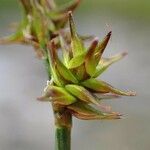Culms 10–90(–135) cm. Leaves 3–6 per culm; sheaths tight, inner band hyaline, 1.8–2.5 cm, apex concave, glabrous; ligules 0.6–2.5(–4.5) mm, rounded to ± acute; blades plicate, 5–40 cm × 0.7–3.3(–3.8) mm, widest leaf 1–3.3(–3.8) mm wide. Inflorescences 0.7–7.8 cm; spikes (2–)3–8; lateral spikes pistillate often with few staminate flowers proximally, 3–15.5 mm, sessile, staminate portion 7-flowered, to 8.2 mm, pistillate portion 3–32-flowered, 2.5–11 mm; basal 2 spikes 1.7–42 mm apart; terminal spike gynecandrous, 5–24 mm, staminate portion 2–17-flowered, 2–16.5 × 0.9–2 mm, pistillate portion 4–26-flowered, 2.6–9 × 4.9–9.1 mm. Pistillate scales ovate, (1.4–)2.1–3.1 × 0.7–2.3 mm, apex acute to sometimes obtuse. Staminate scales ovate-lanceolate to ovate, 1.3–3.8 × 0.8–1.7 mm, base clavate, apex acute. Anthers 0.8–1.6(–2) mm. Perigynia spreading to reflexed, castaneous to dark brown, 2–14-veined abaxially, 0–12-veined adaxially over achene, lanceolate to ovate, (2.65–)2.9–4.75 × 0.8–2.1 mm, (1.7–)1.8–3.2(–3.6) times as long as wide; beak (0.85–)0.95–2 mm, (0.4–)0.45–0.86 length of body, serrulate, teeth (0–)0.15–0.5 mm. Achenes ovate-lanceolate to rhombic-ovate, 1.3–2.1 × 0.8–1.55 mm. 2n = 58.
Stems densely tufted, aphyllopodic, 1–6 dm, scabrous on the angles above; lvs 3–6 per stem, all in the basal third, to about as long as the stems, plicate, mostly 1–2.5 mm wide; spikes 3–7, sessile, small and few-fld, the terminal one with a conspicuous, slender, staminate base, some of the lateral ones often wholly pistillate; bracts small and inconspicuous; anthers 0.8–1.6 mm; perigynia 5–15, crowded, widely spreading or the lower reflexed, green or tan, planoconvex, spongy-thickened at base, lightly several-to many-nerved dorsally, few-to several-nerved or virtually nerveless ventrally, narrowly lance-triangular to move commonly lance-ovate or even ovate, 2.8–3.5(–4) mm, 1.8–3.2 times as long as wide, often serrulate-margined distally, with a prominent, slender, serrulate-margined, sharply bidentate beak 1–1.6 mm, half as long to almost as long as the body; achene lenticular; 2n=50–58. Swamps, bogs, and other wet places; circumboreal, s. to Va. (and in the mts. to N.C.), Ind., Io., Utah, and Calif. Ours is the widespread var. echinata. (C. angustior; C. cephalantha; C. josselynii; C. laricina; C. muricata, misapplied; C. stellulata)
Loosely tufted from an ascending rhizome; tufts ± flaccid. Culms (3.5)–6–35 cm. × c. 0.5 mm., subtrigonous, glab.; basal sheaths grey or light brown. Lvs us. < culms, 0.5–1.5 mm. wide, channelled to flat, margins scabrid, tapering towards the subacute tip. Infl. a compound spike 1.5–4 cm. long, green or pale brown, of 3–5 ± distant spikes, utricles widely spreading when ripe and individual spikes star-shaped; lowest spike us. subtended by a filiform scabrid bract c. ½ length of infl. Spikes androgynous, 3–7 mm. long, male fls at the base of each spike; plants occ. almost dioec. Glumes c. 1/2 length of utricle, membr., light brown, with a pale cream or green well-marked midrib and hyaline margins. Utricles 2.5–4 × c. 1.5 mm., plano-convex, us. distinctly nerved; contracted above to a narrow, dark brown beak with green, slightly or distinctly scabrid margins and slightly bifid orifice; puckered below to a rather indistinct stipe c. 2 mm. long. Stigmas 2. Nut slightly < 2 mm. long, ± biconvex, oblong-ovoid, pale brown.
Loose tufts to 35 cm high. Leaves < stems. Inflorescence 1.5-4 cm long, green or pale brown, of 3-5 ± distant sessile spikes, utricles widely spreading when ripe and individual spikes stellate. Male flowers at base of spikes. Stigmas 2.













